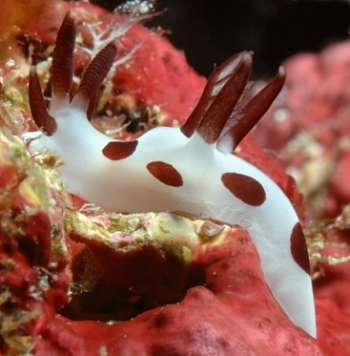
Trapania naeva
Gosliner & Fahey, 2008
Order: NUDIBRANCHIA
Suborder: DORIDINA
Superfamily: ANADORIDOIDEA
Family: Goniodorididae
DISTRIBUTION
Widespread in the Indo-Pacific (Tanzania, Kenya, Rodrigues, Reunion, Maldives, Western Australia, Indonesia, Fiji, southern Japan).
PHOTO
Upper: Osprey Reef, 15 m, Queensland, Australia, Coral Sea, 05 June 2005, coral reef. Photographer: Colin Gans. Lower left: CASIZ 144067, Kerama Islands, Ryukyu, Japan, 7 mm. Photo: A. Ono. Lower right: CASIZ 144067. Radular morphology. Scale =10 µm. [From Gosliner & Fahey 2008: Fig. 28C].
The body is translucent white with large rounded spots of dark brown or black scattered over the body. The anterior tentacular foot corners are white, but the oral tentacles, the dorso-lateral processes, the rhinophores and the gills are dark brown or black except for a short white basal region.
It is reported to grow to at least 20 mm in length.
Note: This species was previously known on the Forum as Trapania sp. 1.
-
Gosliner, T.M. & Fahey, S.H. (2008) Systematics of Trapania (Mollusca: Nudibranchia: Goniodorididae) with descriptions of 16 new species Systematics and Biodiversity, 6 (1): 53-98
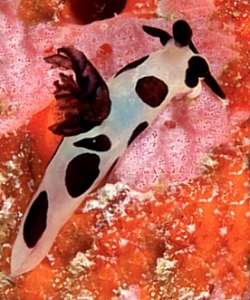
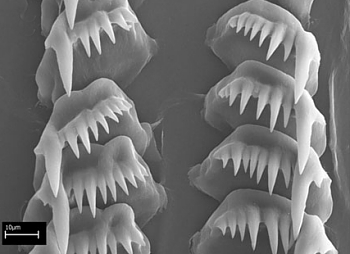
Rudman, W.B., 2008 (March 10) Trapania naeva Gosliner & Fahey, 2008. [In] Sea Slug Forum. Australian Museum, Sydney. Available from http://www.seaslugforum.net/find/trapnaev
Related messages
Re: Trapania naeva? from Indonesia
June 10, 2008
From: Teresa Zuberbühler
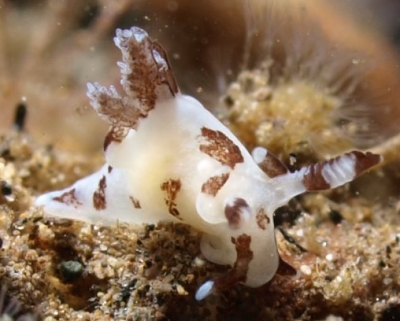
Concerning message #17339:
The picture I send you looks similar to Trapania naeva but the spots are not so distinctive.
This nudibranch is extremely small and difficult to find. Both times I saw it, it was pearching on an piece of wood which was left in the water close to the shore. I asked myself if it is feeding on something which is mainly growing on those logs. Perhaps those polyps (probably hydroids) you see on one of the pictures?
I also send you a picture of what I think are copepods in the gills of Trapania naeva.
Locality: Maumere, 10m max, Flores, Indonesia, Pacific, August 07, muddy with very fine sand mixed with volcanic ash. Length: 7mm to 1cm. Photographer: Teresa (Zubi) Zuberbühler.
Greetings from Switzerland
Zubi
webmaster@starfish.ch
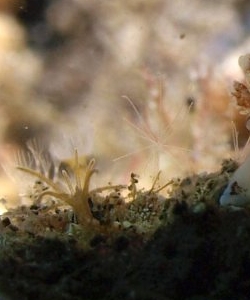
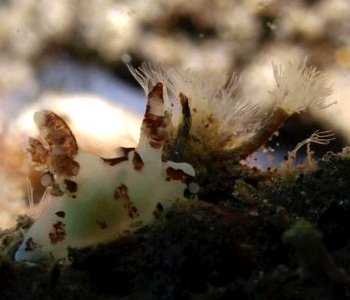
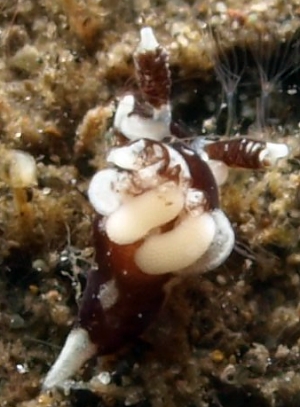
Dear Zubi,
Your animals don't 'fit' nicely with any named species, which is not that surprising, as we don't know much about their colour variability. I guess its best to tentatively identify them as T. naeva, as their brown gills and brown oral tentacles certainly fit - but it is possible they are something distinct.
Concerning what they are eating - species of Trapania seem to feed on kamptozoa, which would be right at home on the piece of wood you have photographed. Looking carefully at your photos I can't see any sign of them, but their zooids could be retracted. There are plenty of other animals present included tube-dwelling polychaete worms, cnidarians [sea anemones?] and possibly phoronids. Many sessile invertebrates have a ring of feeding tentacles which make them look superficially like hydroids.
Your lower photo shows and animal with two large copepod egg masses. Interestingly the background colour of that Trapania appears to be a uniform brown colour, which would be even more unusual for T. naeva.
Best wishes,
Bill Rudman
Trapania sp. 1 from the Coral Sea
August 12, 2006
From: Colin Gans

Note added 12 March 2008: This species has been named Trapania naeva.
Hi Bill
I wonder if you could me identify this nudibranch:
Locality: Osprey Reef, 15 m, Queensland, Australia, Coral Sea, 05 June 2005, coral reef. Photographer: Colin Gans.
Many thanks & regards,
Colin Gans
colin@gans.co.nz
Gans, C.L., 2006 (Aug 12) Trapania sp. 1 from the Coral Sea. [Message in] Sea Slug Forum. Australian Museum, Sydney. Available from http://www.seaslugforum.net/find/17339Dear Colin,
This is a species of Trapania which I am pretty sure is an unnamed species. At present I am calling it Trapania sp. 1.
Best wishes,
Bill Rudman
Re :Trapania sp1 laying eggs?
May 6, 2005
From: Philibert Bidgrain
Note added 12 March 2008: This species has been named Trapania naeva.
Dear Bill,
Concerning your query [message #13669 ]:
According to Benoit De Baize, dive master in Rodrigues Island, several specimens of this species were laying their eggs like that in Sepember in Rodrigues Island . And according to Emmanuel Eby, the photographer, it's evident that they are laying eggs and not crawling....
Best Regards
Philibert Bidgrain
http://vieoceane.free.fr/runseaslug/indexslug.htm
vieoceane@free.fr
Bidgrain, P., 2005 (May 6) Re :Trapania sp1 laying eggs?. [Message in] Sea Slug Forum. Australian Museum, Sydney. Available from http://www.seaslugforum.net/find/13720Dear Philibert,
Thanks for the clarification. I like to check up on interesting observations. Tha almost lace-like shape of the egg ribbon is most unusual.
Best wishes,
Bill Rudman
Trapania sp. 1 from Rodrigues Island
May 4, 2005
From: Philibert Bidgrain

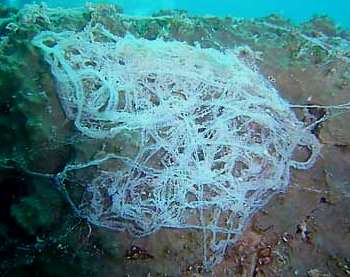
Note added 12 March 2008: This species has been named Trapania naeva.
Dear Bill,
We found these Two Trapania laying their eggs in Rodrigues Island (near Mauritius Island).The specimens were found by Emmanuel Eby in September 2004
Are they what you call Trapania sp 1?
Locality: Rodrigues Island, Indian ocean, Depth: 18 m. September 2004. Photographer: Emmanuel Eby
Best Regards
Philibert Bidgrain
http://vieoceane.free.fr/runseaslug/indexslug.htm
vieoceane@free.fr
Bidgrain, P., 2005 (May 4) Trapania sp. 1 from Rodrigues Island. [Message in] Sea Slug Forum. Australian Museum, Sydney. Available from http://www.seaslugforum.net/find/13669Dear Philibert,
Yes these are Trapania sp. 1. It is a strange looking egg ribbon. Did Emmanuel actually see the animals laying the egg ribbon or did he find them both crawling on it?
Best wishes,
Bill Rudman
Trapania sp.1 from Indonesia
May 3, 2005
From: Roberto Sozzani

Note added 12 March 2008: This species has been named Trapania naeva.
Dear Bill,
this is what I think is a small Trapania sp.1 on Caulerpa racemosa.
Locality: Manado - North Sulawesi, Indonesia. Depth: 15 metres. Length: < 10 mm. June 2003. Dark sand slope with broken corals. Photographer: Roberto Sozzani
Best wishes
Roberto Sozzani
roberto.sozzani@fastwebnet.it
Sozzani, R., 2005 (May 3) Trapania sp.1 from Indonesia. [Message in] Sea Slug Forum. Australian Museum, Sydney. Available from http://www.seaslugforum.net/find/13674Thanks Roberto,
Bill Rudman
Trapania sp. 1 from Kenya
April 29, 2005
From: Valérie Besnard
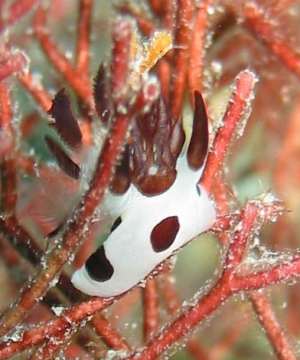
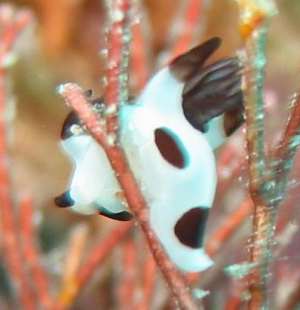
Note added 12 March 2008: This species has been named Trapania naeva.
valeriebesnard@aol.com
Besnard, V., 2005 (Apr 29) Trapania sp. 1 from Kenya. [Message in] Sea Slug Forum. Australian Museum, Sydney. Available from http://www.seaslugforum.net/find/13444Dear Valérie,
This is an unnamed species of Trapania which was first recorded from Western Australia, but it has since been reported on the Forum [as Trapania sp. 1] from Fiji, Reunion Id, Tanzania and the Maldives, so we can say it has a widespread Indo-West Pacific distribution. Species of Trapania are seldom common, often found in ones or twos. Sometimes a group of 10 -20 animals will be found clustered together, but that is an unusual event.
Best wishes,
Bill Rudman
Trapania sp. 1 from Indian Ocean
August 2, 2004
From: Yves Coze & Stefaan Dewulf
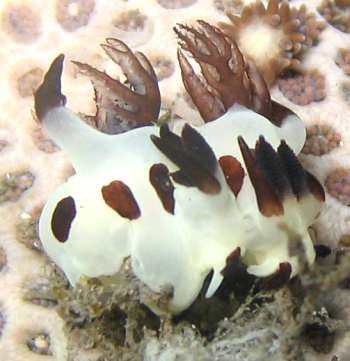
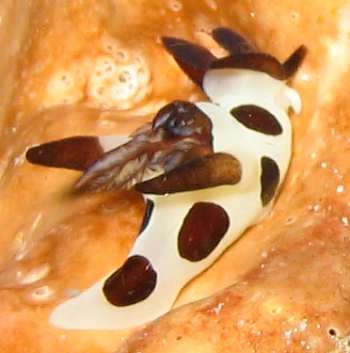
Note added 12 March 2008: This species has been named Trapania naeva.
Dear Bill,
I'm please to notice that you are online again. I've been keeping a picture for some time now. It's seems to be reported as a Trapania sp. 1 on the Forum.
I'm sending them now because we've just spotted two of them here yesterday [30 July 2004] in Reunion Island at the Cap La Houssaye diving spot. Depth approx 12 m. Unfortunately the picture isn't all that good, but it seems they were mating at the time we spotted them [upper and lower photos].
We'll be checking during the next few days in case eggs can be seen there, or if we spot more. It's the very first time we spotted some, though in a local book we found a picture of them. So they seem to be spotted from time to time.
In addition, I spotted one of them last year at Pemba Island [Tanzania] (October 2003) at a depth of approx 20 m on a sponge (no eating evidence) [middle photo]. The diving was called Slobodan Bunker as I recall. I hope this will help to define where these nudis can be found.
Greetings
Yves
dive@rando-reunion.com
Coze, Y. & Dewulf, S., 2004 (Aug 2) Trapania sp. 1 from Indian Ocean. [Message in] Sea Slug Forum. Australian Museum, Sydney. Available from http://www.seaslugforum.net/find/12707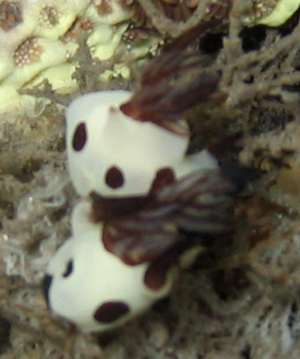
Dear Yves & Stefan,
Thanks for these observations. It certainly seems that this species has a wide distribution in the Indo-West Pacific. I can't be sure if your animals were mating. Opisthobranchs are hermaphrodite [with a fully functional male and female systems]. The copulatory organs open on the right side of their bodies so in mating their right sides have to be touching. I am not sure in the photo alongside, but in the top photo they just seem to be having a chat.
Best wishes
Bill Rudman
Trapania sp. 1 from Fiji
January 13, 2004
From: Jim Chambers
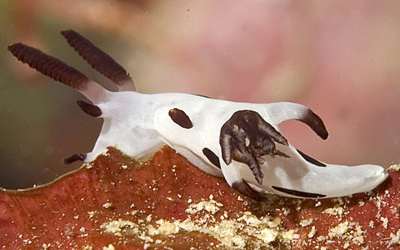
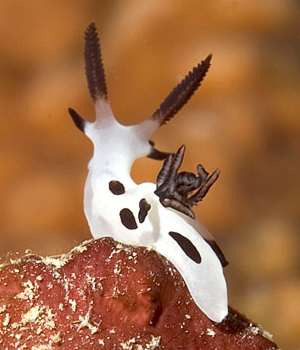
Note added 12 March 2008: This species has been named Trapania naeva.
In December 2003, while diving in Fiji (specifically in the Vatu-I-Ra Channel between Viti Levu and Vanua Levu), I photographed what appears to be a Trapania which I have tentativley identified as the one called Trapania sp. 1 on the Forum. I am reporting this, since I'm not sure if this species has been previously reported in Fiji. This particular area in Fiji is only dived by one dive operator (Crystal Divers) and the occasional live-aboard), so I doubt that there have been many (if any) reports of this species in this location. The divemaster said that he had rarely seen this species, so I doubt that they are very common.
Jim Chambers
jimbo_limited@mindspring.com
Chambers, J., 2004 (Jan 13) Trapania sp. 1 from Fiji. [Message in] Sea Slug Forum. Australian Museum, Sydney. Available from http://www.seaslugforum.net/find/11802Thanks Jim,
Species of Trapania are seldom common, although at times large numbers can be seen at one spot. This makes records such as yours very interesting because it helps to build up a picture of their geographical distribution.
Best wishes
Bill Rudman
Trapania sp. from the Maldives
February 9, 2001
From: John Chuk


Note added 12 March 2008: This species has been named Trapania naeva.
Dear Bill,
I seek your help to identify this nudibranch which I photographed on a dive at Kudiboli Tilla in the Maldives on 21/9/93. Two photo's are attached, both are in situ shots.
The specimen is approximately 15mm in length. It is white with black spots. The gills are black and are positioned about midway along the body. The rhinophores are lamellate, black in colour, with no sign of sheaths. A pair of short, white, oral tentacles were observed. A pair of black papillae arise from the front margin and point forward. Another pair of black papillae are found lateral to the rhinophores. A further pair of large papillae are positioned laterally and slightly posterior to the gills. These larger papillae are white in the bottom half and black in the top half. The specimen was found moving over a green-brown sponge at a depth of 21m. There was no evidence of it feeding on the sponge.
I suspect it is a member of the subfamily Polycerinae but that is as close as I can go. Any further information would be appeciated!
John
jchuk@giant.net.au
Chuk, J., 2001 (Feb 9) Trapania sp. from the Maldives. [Message in] Sea Slug Forum. Australian Museum, Sydney. Available from http://www.seaslugforum.net/find/3666Dear John,
This is an unnamed species of Trapania. There is a photo of it on the Forum from western Australia as Trapania sp. 1.
Best wishes,
Bill Rudman
Trapania from Western Australia.
November 14, 1998
From: Clay Bryce
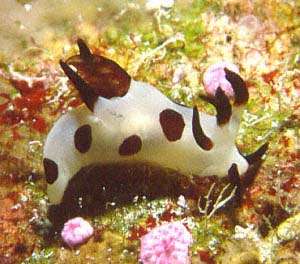
Note added 12 March 2008: This species has been named Trapania naeva.
Dear Bill,
Could this Trapania be new? Any ideas?
Locality: Seringapatam Reef , Scott & Seringapatam Reefs, Timor Sea, North-western Australia. PHOTO: Clay Bryce
best wishes,
Clay
Clay Bryce
Western Australian Museum
Perth,
WA 6000.
brycec@museum.wa.gov.au
Bryce, C., 1998 (Nov 14) Trapania from Western Australia.. [Message in] Sea Slug Forum. Australian Museum, Sydney. Available from http://www.seaslugforum.net/find/304Dear Clay,
It is possibly undescribed. It has similarities in colour to Trapania darvelli which is identical in colour except it doesn't have brown spots. It is also similar to Trapania japonica which has brown spots, brown head tentacles and rhinophore clubs and gills but the lateral processes are bright yellow. The radula has proved a useful character so if you want to send over the specimens I could have a look. .. Bill Rudman
